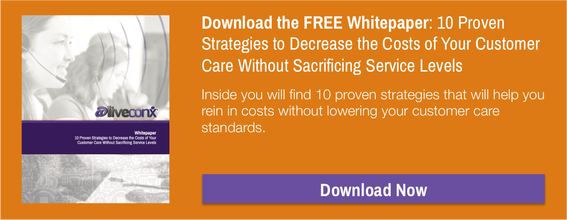A Journey of 1,000 Miles: The Future of Customer Service
Customer expectations for service are evolving fast, creating the need for a better understanding of the customer experience from beginning to end.
There was a time when customer service was simple.
Well, maybe not simple, but different from the world of customer service as we know it today.
The Internet has had a tremendous impact on the way businesses and customers interact, including changing customer expectations for what constitutes quality service. Information is almost too easy to find these days, making consumers less dependent on live agents to solve their problems.
Sure, your centre should check the usual boxes like keeping your average handle time low and first contact resolution high, but metrics alone aren’t enough to guarantee a solid customer experience any more.
Customer service is moving away from the typical problem/resolution paradigm and instead is focusing more on building stronger relationships with consumers. These relationships provide the backbone for a loyal following of customers whose needs are understood and easily addressed by the businesses they choose.
Cutting-Edge Customer Service
A 2014 Customer Service Survey done by American Express found that 99 percent of consumers believe that receiving satisfactory answers to their problems and getting connected to knowledgeable staff are important factors in good customer service.
With this in mind, it’s important to note that this “good” customer service still fits in the transactional model, functioning as a means to an end to make customers happy. Was their problem resolved? Are they satisfied? Getting a yes to both of these questions is an important part of good customer service, but consumer expectations have now evolved beyond this. Customers expect their service providers to understand their needs before having to explain it.
With this in mind, the new goal of your customer service initiatives should centre around building a relationship with your customer. Instead of a simple yes/no transaction, customer service should be measured on the overall impact that each interaction has and how it improves your customer relationship.
A New Type of Experience: The Customer Journey
The Internet isn’t only altering customer expectations; it’s also changing the way customer service works in the contact centre. Information is easier to find than ever, and many customers prefer to find their own solutions online before resorting to a live agent. The impact of this trend is substantial, with nearly half of businesses that provide self-service web options reporting a decrease in phone inquiries and email traffic, according to a study conducted by Unisphere Research.
Aside from the decrease in call volume, the tendency to find solutions online before contacting customer service presents a unique challenge to agents, who interact with customers less and less. Given the ease with which customers can now find solutions themselves, customer service agents should take every possible opportunity to deliver a personalized touch to every customer interaction.
To provide this type of personalized outreach, effective agents must understand their customer’s end-to-end experience and what they value about interacting with live agents. Your contact centre should glean customer data from CRM and data collection systems.
But identifying the data isn’t enough. If you’re only focusing on the information after the fact, you’re already too late.
Businesses need to be ahead of their customer’s expectations, not struggling to meet them. Part of this involves mapping each step of the customer experience journey to better understand how to meet your customer’s needs:
- Discovery: How did they learn this experience was available?
- Planning/Enrolling: Do they need to sign up to have this experience?
- Arrival: When does the experience begin?
- Engagement: What do customers value most during their experience?
- Completion: How do customers end their experience?
- Reflection: Do they follow-up on the experience with reviews, social media comments, or participation in reward and loyalty programs?
Whether they’re the type who prefers fast resolutions to their issues or prefer to be walked through the problem solving process, knowing how to leverage customer information into a better experience is a fundamental part of where customer service is headed in the future.
Opportunities for Growth
While the general state of customer service is improving to meet the changing needs of the consumer, it’s a process of slow change. Customers still aren’t fully accustomed to an exceptional customer service experience that addresses their needs every step of the way, more frequently encountering traditional forms of service that meets their needs in the most basic ways.
This creates a potential market for savvy businesses to make their mark. By taking advantage of the changing expectations for quality customer service, call centres can differentiate themselves from their competitors and provide a level of service that is more personalized and effective than most.
Interested in learning more about how to improve your customer’s experience in an ever-changing market? Download our free white paper!










